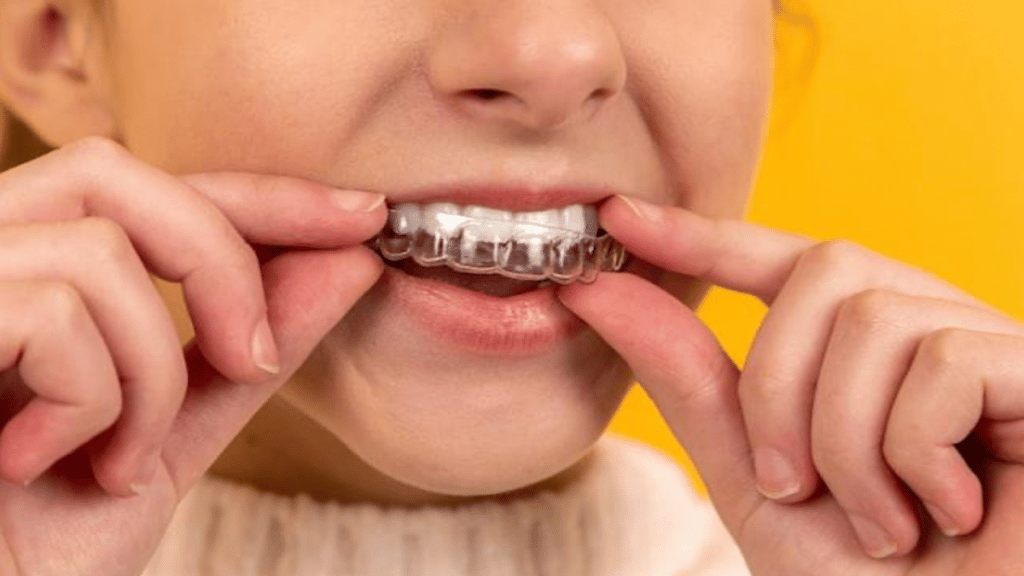Clear aligners are a treatment that has been launched on the market relatively recently, which consists of the manufacture of a custom-made transparent splint that wraps around the teeth to control the movement of the teeth towards the correct position. As the splint is invisible, other people will not notice that you are wearing it. The splint is made of plastic materials and is changed approximately every two weeks, according to the indications of specialists. This treatment is removable, as mentioned above, so the patient can remove the aligners whenever they need to, for example, when eating. In addition, the treatment time is usually similar to that required with braces orthodontics. Another feature of Impress clear aligners is that your first visit to the clinic, before starting treatment, will be free and you will have support throughout your treatment 24 hours a day, 7 days a week.
Many questions asked by patients are related to the attachments of this treatment, therefore, in this article you will find a lot of information related to the subject that can solve many of your doubts.
What are Attaches?
The attachments are small reliefs, approximately 1 or 3 millimetres, which are placed on the teeth, specifically on each of the teeth, to facilitate the application of force exerted by the splints on the teeth. They are very aesthetic, transparent or tooth-coloured and are removed at the end of orthodontic treatment.
How many Attachments are Fitted?
As with the choice of splints and their design, the placement of attachments is completely personalised for each client. Therefore, each patient will need a certain number of attachments. They may only need them on certain teeth, depending on their particular case.
Also, the attachments do not necessarily have to be placed on the same teeth throughout the treatment, but may change depending on the stage of the treatment and the evolution of the patient’s teeth as the weeks go by.
Do the Attachments Hurt?
The attachments do not hurt or cause any kind of discomfort. At first you will notice a slight relief on the surface of the teeth, but you will adapt quickly. It is not uncomfortable for brushing or eating. You may notice some slight pressure from the clear aligners each time they are changed (every two weeks or so) but it is not painful.
Types of attachments
Attachments are small composite reliefs that are bonded to specific teeth, depending on the individual patient. This allows the aligner to better grip the tooth so that it can carry out the micro-movements that the teeth make to get into the right position. There are different types of attachments, depending on their size and shape, which vary according to their purpose.
The choice of one or the other depends on the movement to be carried out and the tooth to which it is attached. Depending on their purpose, attachments are classified into the following types:
- Rotation: they allow the upper and lower canines to rotate.
- Extrusion: facilitates the extrusion of upper and lower anterior teeth.
- Multi-tooth anterior extortion attachments: Can be placed on the upper incisors.
- Root straightening: the attachments get the root of the teeth into the right shape.
- Multiplane attachments: These can be placed on the upper lateral incisors and are used for combined movements.
- Deep bite: They can be placed on upper and lower premolars. They are used to prevent them from moving (passive) or to extrude them (active).
- Multidental unit attachments: There are two types: retraction attachments which are placed on upper and lower canines and anchorage attachments which are placed on upper and lower second premolars and molars.
Depending on the shape of the attachment, there are other types:
- Ellipsoidal conventional attachments: they can be placed vertically or horizontally and are 3 mm long, 2 mm wide and 1 mm thick.
- Rectangular conventional attachments: They can be 3, 4 or 5 mm long depending on the type of movement and the morphology of the tooth. Their width and thickness is the same as the ellipsoidal ones. They can also be bevelled to favour a specific movement and to facilitate the disinsertion of the aligners if necessary in a specific case.
- Optimised attachments: they have specifically designed shapes so that a specific movement is made for each tooth. Therefore, the size and position cannot be modified. There are several types and each of them is used for particular teeth. Molars are the only teeth that do not have optimised attachments available.
From the above it can be concluded that the attachments are just another part of the Impress clear aligner treatment.
They do not affect the comfort or aesthetics of the treatment and although their presence may seem insignificant when it comes to moving the teeth, they serve to make the treatment faster and more effective.
Despite all of the above, the most important thing is to get information before undergoing orthodontic treatment and to go to a good, experienced orthodontist who knows what is best for each patient.

